Solar cookout aims to woo traditional chefs, cut carbon
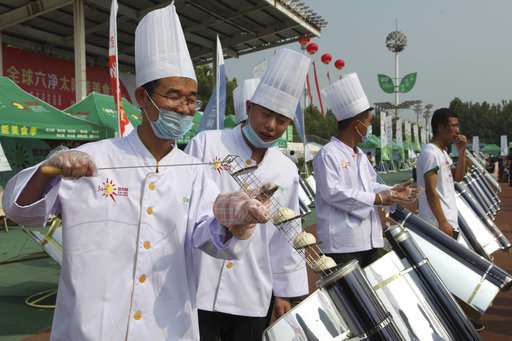
The savory aromas of roasting hot dogs and chicken kebabs wafted out of metal and glass vacuum tubes heated by mirrors curved to capture the sun's heat.
Two dozen chefs with white aprons and hats prepared soups, baked "baozi" pork buns, and boiled rice porridge at a festival designed to demonstrate the potential of solar cookers that organizers claim can help reduce climate-changing greenhouse gas emissions.
"We aim to enable half of the world's population to use solar cooking within 10 years," said Huang Ming, founder of Himin Solar Energy Group, the solar cookout's main backer.
As hundreds of people strolled by, chefs armed with oven mitts scaled ladders to uncover piping-hot cooking tubes arrayed on nearly 2-meter (6-foot)-tall industrial racks. Smaller-scale vendors used 1-meter (3-foot)-long solar cookers designed to fold up for picnics.
Temperatures can top 400 C (750 F) inside the black "BBQ tubes" of metal and glass with turnip-tipped bottoms and sealable tops. On a bright day, they can boil water within 30 minutes and roast a fish in half that time, according to Himin.
"It is clean and smoke-free . better than cooking with pots and other things," said Yu Liqiu, 22, a chef, who just began cooking with solar two days earlier.
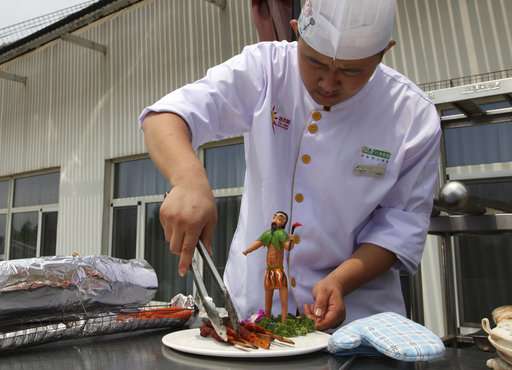
Dezhou, a sprawling city of 5 million in eastern China, has spent millions since 2005 on transforming itself into an aspiring renewable energy hub called the "Solar Valley."
Public art displays at town bus stops and murals use solar panels. Stone statues of sun-related Chinese legends squat in parks.
China is the world's biggest consumer and producer of solar technologies. Many homes outside the largest cities are equipped with solar water heaters.
But roughly 600 million of China's 1.4 billion people still cook with coal, wood or other biomass despite decades of government-led initiatives to curtail soot from such burning, according to a 2016 report by the Global Alliance for Clean Cookstoves.
Affordable yet durable solar cookers have long intrigued those seeking to cut emissions, said Frank Haugwitz, director of Asia Europe Clean Energy Solar Advisory Company.
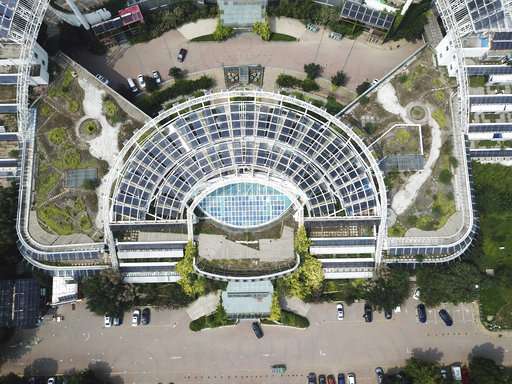
"There's a certainly a need for a cleaner option," he said.
Eastern China is a "global hotspot" for black carbon emissions—sooty particulates more damaging to health and the environment than typical greenhouses gases—according to a 2007 report in the academic journal Nature. Half of China's black carbon comes from residential kitchens and heaters.
Sun Penglong, 27, worked in gas kitchens in Dezhou for years before switching to solar. He says new recipes must be invented and tested for solar cooking, but there is one unexpected perk: His wife doesn't complain about the smell he used to bring home in his workclothes.
"The first thing my wife used to ask me to do after returning home was to shower," Sun said after roasting some beef skewers in a BBQ tube.
"When I started as a solar chef, my wife asked me, 'Where is your smell?'"
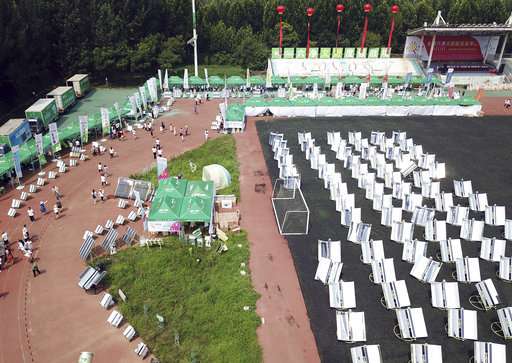
But getting solar cookers to the masses has proven daunting.
Solar cooker technology has not yet matured. While cheap types are available, more reliable ones are still too expensive for rural communities. "It's kind of a chicken and egg thing," Haugwitz said.
Some experts fear solar is too big a break from traditional Chinese cooking.
"It is good to have some innovation, but it's impossible to change people's dietary habits," said Xu Qinhua, deputy director of National Academy of Development and Strategy under Renmin University of China.
"People used to say China's fire-fried dish culture would be replaced by induction cookers, but no, it was not."
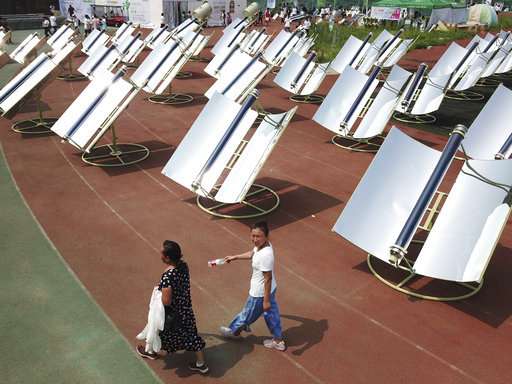
Himin has yet to produce a retail version of the cooker or sell it outside of Dezhou but the company claims chefs in the city are already adapting cookers gifted to them to a variety of regional Chinese cuisines in new solar restaurants opening up across the city.
In the solar-panel festooned Micro-E Hotel, next to the field where the festival was staged and down an air-conditioned hall past portraits of Al Gore and other climate advocates, Huang and other festival goers toasted the vacuum-tube solar cookers with glasses of fiery baiju, red wine and beer.
Next came a marathon banquet of courses, including turtle soup and pancakes served on platters with foot-tall figurines of Chinese legends like the mythical archer Houyi. According to legend, he shot dead nine suns before harnessing fire for humanity's benefit.
Ren Yanbo, vice secretary general of the Efficient Stove Division of the China Association of Rural Energy Industry, appeared to be won over.
"I was impressed by the taste of pig feet cooked by solar, it was soft and yummy, I could not believe it was cooked by solar," she said.
-
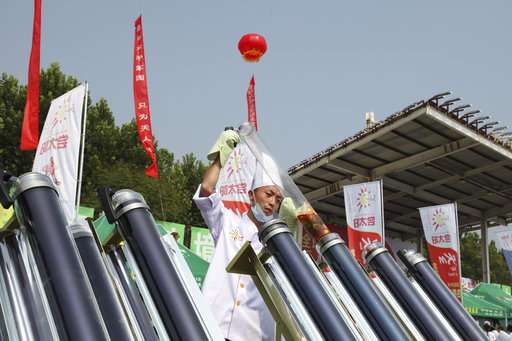
In this photo taken Thursday, Aug. 2, 2018, a chef prepares to cook food in a solar cooker which uses a metal and glass vacuum tube heated by mirrors curved to capture the sun's heat in Dezhou in the eastern Shandong province in China. Two dozen chefs with white aprons and hats cooked soups, baked buns, potatoes, and boiled rice at a festival to demonstrate the potential of solar cookers that organizers claim can help reduce climate-changing greenhouse gas emissions. (AP Photo/Fu Ting) -
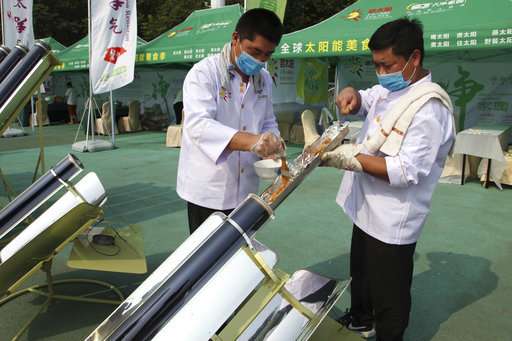
In this photo taken Thursday, Aug. 2, 2018, chefs prepare to cook skewers of meat in a solar cooker using a metal and glass vacuum tube heated by mirrors curved to capture the sun's heat in Dezhou in the eastern Shandong province in China. Two dozen chefs with white aprons and hats cooked soups, baked buns, potatoes, and boiled rice at a festival to demonstrate the potential of solar cookers that organizers claim can help reduce climate-changing greenhouse gas emissions. (AP Photo/Fu Ting) -
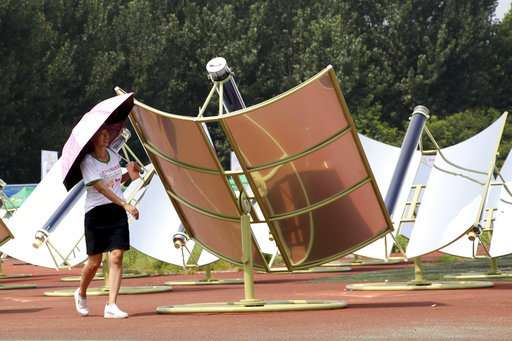
In this Thursday, Aug. 2, 2018, photo, a woman rotates a solar cooker, a device using a metal and glass vacuum tube heated by mirrors curved to capture the sun's heat, to face the sun in Dezhou in the eastern Shandong province in China. Two dozen chefs with white aprons and hats cooked soups, baked buns, potatoes, and boiled rice at a festival to demonstrate the potential of solar cookers that organizers claim can help reduce climate-changing greenhouse gas emissions. (AP Photo/Fu Ting)
Journal information: Nature
© 2018 The Associated Press. All rights reserved.




















